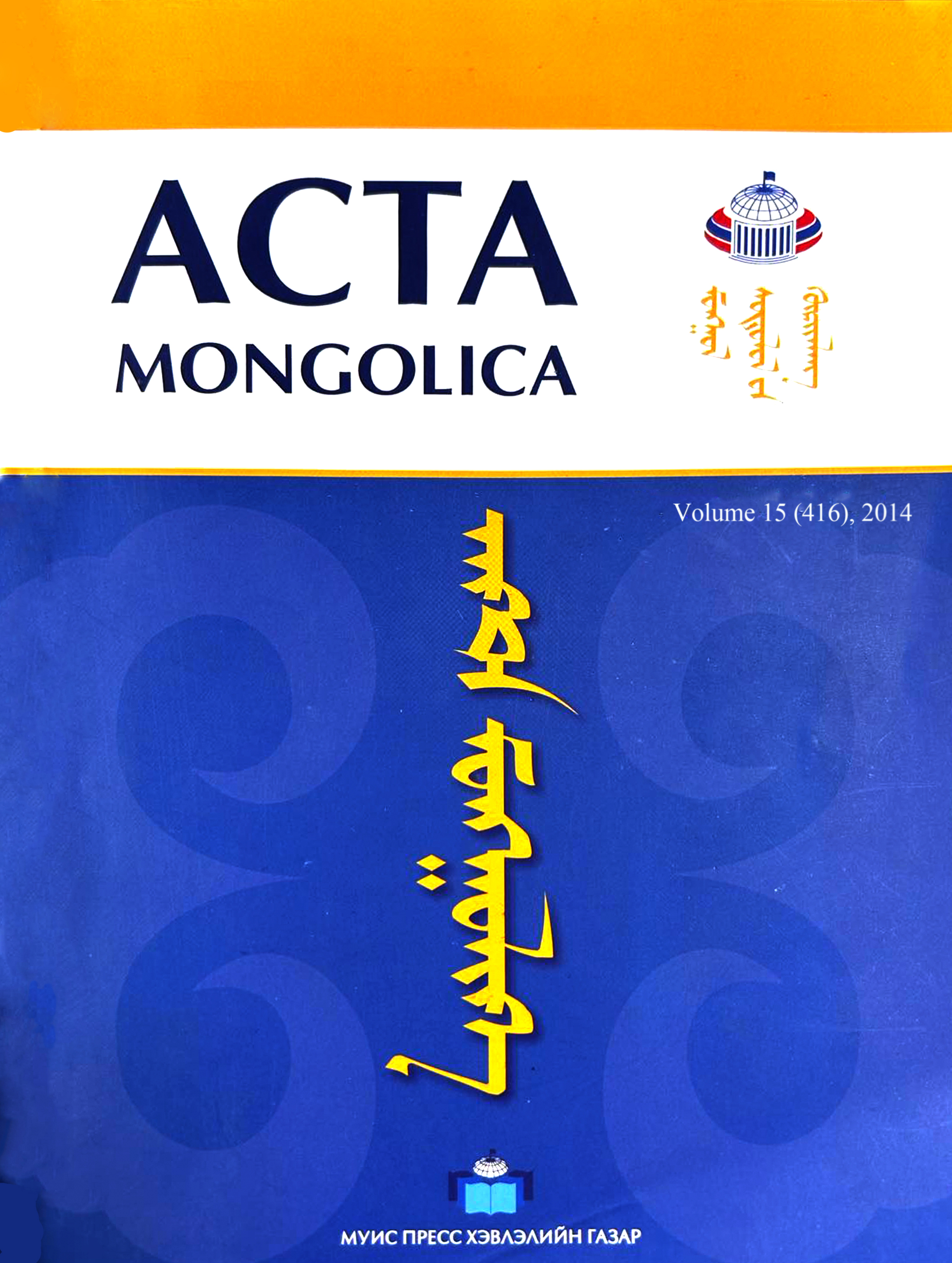ОЮУ ЧИХТ ХАН ХӨВГҮҮНИЙ ТУУЖ ОРШИВ ЗОХИОЛЫН ЭХ СУРВАЛЖУУД
Main Article Content
Abstract
From the Buddhist expansion in the 17th century, India, Tibet, and Mongolia became connected through literature as they influenced each other in that regard. One such example is a text known as ‘The legend of Prince Gyü čiketü’ whose main topic, composition, and story line is inspired by Buddhist doctrine of filial piety. A comparative study of this Mongol text reveals similarities with the following Indian and Tibetan texts.1.A Mongol version of the Indian legend about King Vicrāmadya, (Boγda Biγarmijid qaγan-u terigün debter) in its Volume 1, section 14 that reads: ‘The tale of the vampire wife is the 13th chapter of the Mongol collection of tales concerning king Vikramaditya and his throne, Bigarmijid’, translated by and was published in Bawden, C. R. 1960. Tales of King Vikramaditya and the Thirty -two Wooden Men. New Delhi. 155-162, no.13 The text portrays King Vicrāmadya as Gyü čiketü (prince Turquoise-ears) who defeated the devil and inspired by the main topic in literature, the young prince goes to live with his step-mother.
Article Details

This work is licensed under a Creative Commons Attribution-ShareAlike 4.0 International License.
References
Artasiddhi qaγan köbegün-ü čadig. (Монголбичгээр.)
Ch. Bawden Mongolian Traditonal Literature: An Anthology. London. 2004.
“The tale of the vampire wife is the 13th chapter of the Mongol collection of tales concerning king Vikramaditya and his throne, Bigarmijid”, translated by and was published in Bawden, C. R. 1960. Tales of King Vikramaditya and the Thirty-two Wooden Men. New Delhi. 155-162, no. 13. http://mem bers. home.nl /marcmarti/ yugur/folktale/tale16b. htm.
А. П. Бенингсен, Легендыисказки ЦентральнойАзии. СанктПетербург 1912. #30. СказкаобъОнохоръ-Турлектэхане 57-68 стр.
Boγda Biγarmijid qaγan-u terigün debter (Монголбичгээр). УҮННСанд 1639. 179-199 тал.
ЭрхэлсэнД. Ганболд. Уб., 2005. Gegeēn toli orоšiboi /ГТX1/ (Тодүсгээр). УҮННСанд 8409/96 294.3.Г-897.
Gegeēn toli orоšiboi /ГТX2/ (Монголбичгээр). УҮННСанд 8434/96.294.Г-897.
Г.Гэрэлмаа, Хэл зохиолын хүрээлэнд хадгалагдаж буй тод номын товч бүртгэл. Уб., 2005.
Лувсанбалдан, Х. Тодүсэг, түүнийдурсгалууд.Уб., 1975.
Монголынуранзохиолынтойм II, ред. Ц. Дамдинсүрэн, Уб., 1977.
А. Мөнхцэцэг, Оюу чихт хан хөвгүүний тууж зохиолын зохиогчийн тухай Acta Mongolica 2013. Vol.14 (400): 162-1676
А. Мөнхцэцэг, XVII зууны үеэс Монголд дэлгэрсэн хойт эх-дагавар хүүхдийн сэдэвт зохиолуудын харьцуулалт (Хэвлэлтэнд.) Oyu čikitü xaān köböǖni toūji orošiboi /ОЧХX, Х1/ (Тодүсгээр). ХИС. ТоБNo95.
Rabjamba Cay-a bandita-yin tuγuji saran-u gerel kemekü ene metü bolai (Монголбичгээр). CSM. T-V, Fasc.2. Уб., 1959. 16.Sakyapa Sonam Gyaltsen The Clear Mirror. Translated by. McComas Taylor and Lama Choedak Yuthor. New-York, 1996. 17.Тунгалаг, Б. МУҮНСдахьтодбичгийнсудрынгарчиг. II. Уб., 2006.
Ünekeēr törölkitü sayin xaāni toūji orušibui./ Х2. (Тодүсгээр.) УҮННСан 8308/96 401.
Üneker törülkitü sayin qaγan-u tuγuji orušibui. / Х3. (Mонголбичгээр.) УҮННС7963/96 89 v-856.
Л. Хүрэлбаатар, “XV-XVI зууныүеийнорчуулгынзохиол” Монгол орчуулгын товчоон (Сонгодог орчуулгын зарчим, уран чадварын асуудалд). Уб., 1995.; Тод бичиг болон Заябандида Намхайжамц судлалын асуудал Bibliotheca Oiratica-XIII. Уб., 2009: 95-105.
Цэрэнсодном, Д. “XVII-XVIII зууныүеийнуранзохиол” Монголын уран зохиолын судлалын шинэ хандлага.Уб., 2008.

